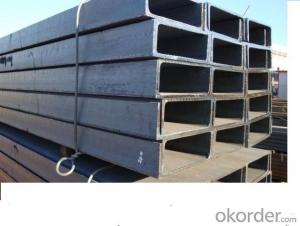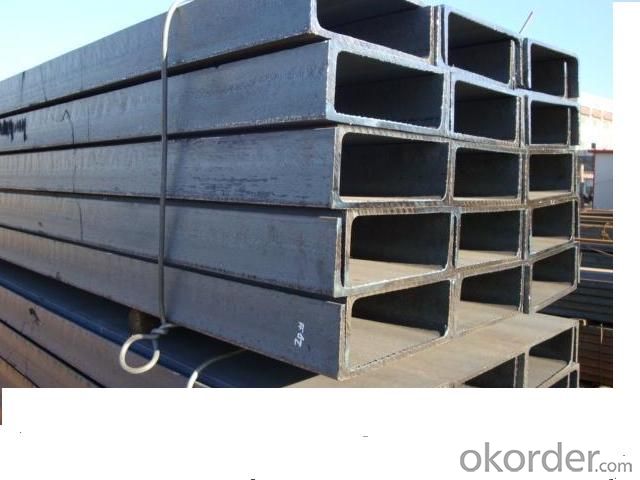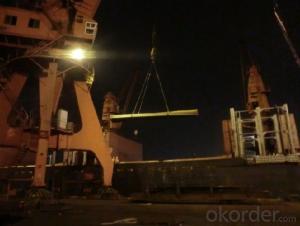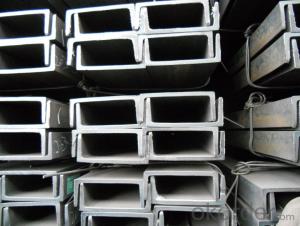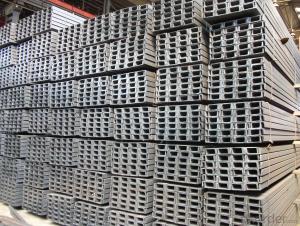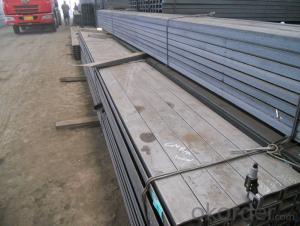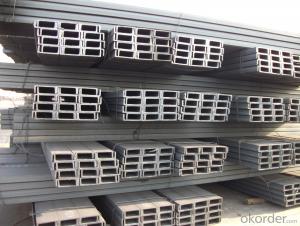High Quality 28# Steel Channel
- Loading Port:
- China Main Port
- Payment Terms:
- TT OR LC
- Min Order Qty:
- -
- Supply Capability:
- -
OKorder Service Pledge
OKorder Financial Service
You Might Also Like
Steel Channel
Standard: GB
Material: Q235
Length: 6m, 12m
Size:
| Size (mm) | Mass (Kg/m) |
| 280*82*7.5 | 31.427 |
| 280*84*9.5 | 35.823 |
| 280*86*11.5 | 40.219 |
The chemical composition of HR Channel Steel according to Q235B is shown in Table-1.
Alloy No | Grade | Element(%) | ||||
C | Mn | S | P | Si | ||
Q235 | B | 0.12-0.20 | 0.3-0.7 | ≦0.045 | ≦0.045 | ≦0.3 |
Table-1
Note: we are able to present our customers relevant SGS test report for chemical composition of HR Channel Steel.
The mechanical property of HR Channel Steel according to Q235B is shown in Table-2
Alloy No | Grade | Yielding Strength Point(Mpa) | |||
Thickness(mm) | |||||
≦16 | >16-40 | >40-60 | >60-100 | ||
≧ | |||||
Q235 | B | 235 | 225 | 215 | 205 |
Table-2
Package & Delivery of Channel:
1.The hot rolled channel steel will be packed in bundle with steel wire at each end of every bundle and color marking in order to help the customer to recognize his goods more easily at sight.
2. And the hot rolled channel steel could be loaded into 20ft or 40ft container, or by bulk cargo.If the weight of each bundle reaches more than 3.5 mt, the loading by break bulk cargo should be choosed.When the weight of each bundle reaches less than 3mt, the loading by container should be choosed.
3.As for the transportaion from mill to loading port, the truck will be usually used. And the maximum quantity for each truck is 40mt.
4.All in all, we could do in accordance with customer's request.
*If you would like to get our price, please inform us the size, standard/material and quantity. Thank you very much for your attention.
- Q: Are steel channels suitable for use in exhibition displays?
- Yes, steel channels are suitable for use in exhibition displays. They are strong, durable, and can provide a stable framework for various exhibition elements such as panels, boards, signage, and lighting fixtures. Additionally, steel channels can be easily customized and are available in various sizes and finishes, making them versatile for different display designs and configurations.
- Q: What are the different types of clamps used for steel channels?
- There are several different types of clamps used for steel channels, including beam clamps, channel clamps, strut clamps, pipe clamps, and C-clamps. Each type of clamp is designed to securely hold steel channels in place and provide support for various applications.
- Q: How do steel channels contribute to the overall efficiency of a building?
- Steel channels contribute to the overall efficiency of a building in several ways. Firstly, they provide structural support, enhancing the strength and stability of the building. This allows for the construction of taller and larger structures, maximizing the use of space. Additionally, steel channels can be used to create open floor plans, allowing for flexible and versatile layouts. Moreover, steel channels are lightweight yet durable, making them easy to transport and install, reducing construction time and costs. Lastly, steel channels have high resistance to fire, corrosion, and pests, ensuring the long-term durability and safety of the building.
- Q: How to choose angle steel and channel steel for dry hanging stone?
- The common hanging has three forms, 1. dry hanging marble glue glue, hanging, hanging this way without steel; 2. Jane hanging, generally used for small area low wall span, low height, suitable for the basic solid floor or wall buildings by directly using the 50-60 to use the national standard angle extended expansion bolt fixed on the wall of the keel, the installation of vertical keel lost; 3 steel frame, standard hanging form, generally uses the 8-10, GB steel keel (vertical keel), master of 50-60 angle steel do keel (transverse keel), and vertical keel connected by welding. The higher the floor installation, the greater the relative size of the selected material, which is the basic law!
- Q: What are the different methods of connecting steel channels?
- Connecting steel channels can be accomplished through various methods, each tailored to specific applications and structural needs. Some commonly employed techniques include: 1. Welding: Among the most popular methods, welding involves melting the metal at the joint and fusing it together. It results in a robust and permanent connection. Different welding techniques, such as arc welding, MIG welding, and TIG welding, can be utilized. 2. Bolting: By utilizing bolts, nuts, and washers, steel channels can be securely fastened. Holes are drilled in the channels, and bolts are inserted and tightened with nuts. This method allows for easy disassembly and reassembly, making it suitable for applications requiring frequent adjustments or modifications. 3. Riveting: Riveting, a traditional approach, involves using cylindrical metal pins called rivets to hold steel channels together. These rivets are inserted through pre-drilled holes and then hammered or pressed to secure them. This method ensures a sturdy and durable connection. 4. Adhesive bonding: This method employs industrial adhesives or epoxy resins to bond steel channels. It is particularly useful when aesthetics are important, as it leaves no visible fasteners. However, it may not be suitable for applications that require high load-bearing capacity. 5. Mechanical connectors: These connectors are specifically designed to link steel channels without the need for welding or drilling. They typically consist of clamps or brackets that can be secured to the channels using bolts or screws. Mechanical connectors provide a quick and efficient means of connection, enabling easy installation and disassembly. Ultimately, the choice of connection method depends on factors such as load-bearing requirements, structural design, ease of installation, and the need for adjustability or disassembly. It is recommended to consult with a structural engineer or a professional in the field to determine the most appropriate method for a specific application.
- Q: Do steel channels have any specific deflection limitations?
- Yes, steel channels have specific deflection limitations. The deflection of steel channels depends on various factors such as the size, shape, and thickness of the channel, as well as the applied load. To ensure structural integrity and prevent excessive deflection, engineers typically follow industry standards and design codes that specify maximum allowable deflection limits for different applications.
- Q: What are the different types of steel channel connections for roof trusses?
- There are several types of steel channel connections commonly used for roof trusses, including bolted connections, welded connections, and riveted connections. Each type offers different benefits and considerations in terms of strength, cost, ease of installation, and maintenance. The choice of connection type depends on factors such as the load requirements, design preferences, and available resources.
- Q: Can steel channels be used in the construction of bridges?
- Yes, steel channels can be used in the construction of bridges. Steel channels provide structural support and stability, making them suitable for use in bridge construction. They offer high strength-to-weight ratio, corrosion resistance, and durability, making them an ideal choice for various bridge applications.
- Q: What is the difference between channel steel and angle steel?
- The cross section of the channel steel is concave, and the cross section of the angle steel is L, forming a 90 degree angle
- Q: What kind of steel products are there, such as channel steel, angle iron and so on?
- DiskDisk is like wire like disc steel together, is a kind of construction steel. Steel is widely used in all kinds of building structure, the advantages of screw thread steel is screwed in screw thread steel is only 9-12, can be screwed by the use of random intercept needs.
Send your message to us
High Quality 28# Steel Channel
- Loading Port:
- China Main Port
- Payment Terms:
- TT OR LC
- Min Order Qty:
- -
- Supply Capability:
- -
OKorder Service Pledge
OKorder Financial Service
Similar products
Hot products
Hot Searches
Related keywords
